Urasenke Midorikai Alumni Gather in Kyoto
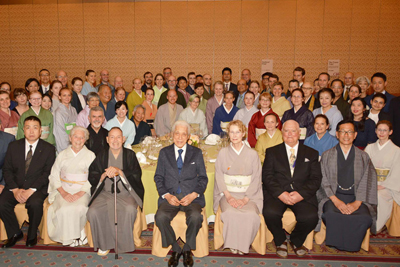 |
| Commemorative photo with Daisosho SEN Genshitsu (front row, center) at the dinner party he hosted for the alumni. (June 26, 2018, ANA Crowne Plaza Hotel) |
| In 1970, SEN Genshitsu (SEN Soshitsu XV) established an official class for non-Japanese students at the Urasenke Headquarters in Kyoto as one way of putting his ideal of "Peacefulness through a Bowl of Tea" into practice. By making the study of chado, the Japanese way of tea, possible in English and providing full financial assistance, he encouraged the study of chado by students around the world, and thereby manifested his deep commitment to the goal of promoting world peace through mutual understanding. In 1973, he named the group Midorikai, and in 1976, Midorikai became a division of the Urasenke Gakuen Professional College of Chado. To date, over six hundred people, coming from more than thirty countries in North and South America, Europe, the Middle East, Asia, Africa, and Oceania, have participated in the Midorikai program. Fifty-three of those Midorikai alumni, from twenty different countries and representing students from the early 70s to the present time, took part in a special study program in Kyoto from June 26 to 30, 2018, which was organized by the Urasenke Midorikai Alumni Association (UMAA). It was the first time that such a major group of Midorikai alumni ever gathered at the home of Urasenke, where they had once studied as Midorikai students. On June 25, the day before the start of the study program, forty-four of the participants visited Jukoin temple, Daitokuji, to pay their respects at the tomb of SEN Rikyu, founder of the Sen family. Besides going to the cemetery, they also received explanations about the main temple building and tea rooms. |
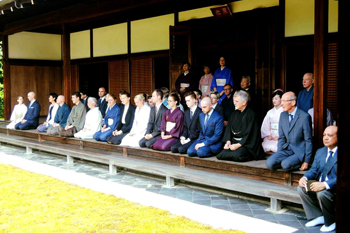 |
| Photo courtesy of Bruce S. Hamana |
| At 8:00 the morning of June 26, the fifty-three member contingent convened in the large upstairs room of the Chado Kaikan at Urasenke headquarters, for a brief orientation before going to the Heisei Chashitsu. They were seated in the Chofu-no-ma of the Heisei Chashitsu by 8:45, for the opening ceremony. Just at this time, Daisosho dropped by for a few minutes, to welcome everybody before he dashed off to keep an appointment. He expressed his joy at seeing everyone, and said that his late wife, Tomiko, would be as happy as he is that each of them is keeping active in chado. He encouraged them to "soak up the real aroma of tea" during their next few days in Kyoto. Before leaving, he greeted each of the participants individually. |
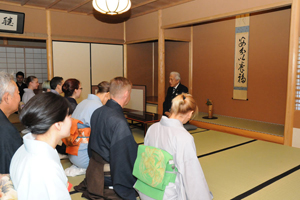 |
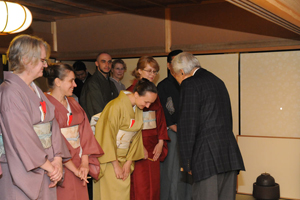 |
| The five Konnichian gyotei teachers who would be providing instruction over the next two days were then introduced. The gyotei team for this UMAA seminar was headed by SUMI Soko and included YAMAMOTO Sochi, FUSHIDA Sokei, IZUMIMOTO Sogen, and SUZUKI Sokei. This day's study began with warigeiko under the guidance of gyotei Sumi. Then the participants divided into five groups, which went to different rooms to receive temae instruction and to also review the procedures for being a guest. On day two, June 27, the tea room study focused mostly on the shichijishiki group training exercises. The participants again divided into five groups, which was done each day according to a carefully organized schedule so that they could receive instruction from as many of the gyotei as possible. |
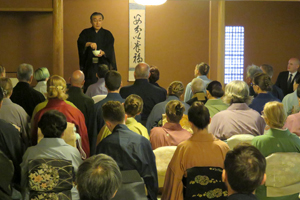 |
| Scene during the warigeiko with gyotei Sumi. |
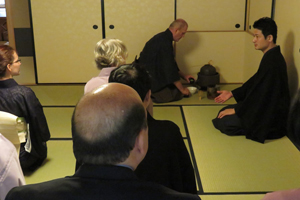 |
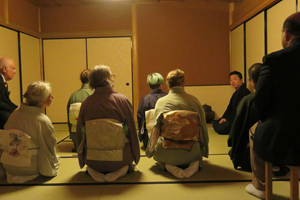 |
| Day one morning class with gyotei Yamamoto. |
Day one morning class with gyotei Fushida. |
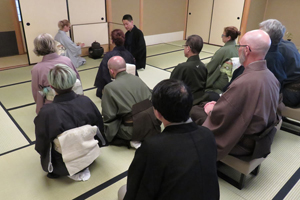 |
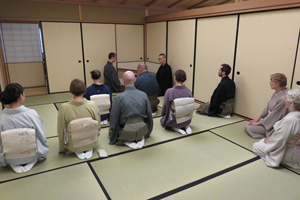 |
| Day two afternoon class with gyotei Izumimoto. |
Day one morning class with gyotei Suzuki. |
| The evening of the first day, they were invited to a welcome dinner party hosted by Daisosho at the ANA Crowne Plaza Hotel, located across from Nijo Palace. Joining the alumni at this party were the gyotei teachers in charge of this time's seminar, Midorikai-related Urasenke Gakuen and Tankokai staff, and all the current students of the Midorikai. A highlight of the evening was a surprise raffle with prizes provided by Daisosho, and Daisosho doing the drawing. The prizes included two tea bowls - one, an Akane-gama work, and the other, an Asahi-yaki work; an incense container made by Ohi Chozaemon X (Toyasai); five shikishi poem cards written by Daisosho; and, as the grand prize, a scroll written by Daisosho. |
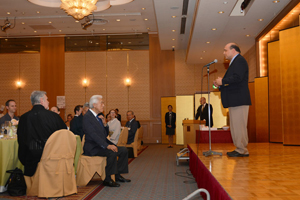 |
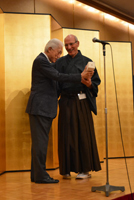 |
| UMAA Vice President Karl FOOKS gives an opening speech at the dinner party. |
Daisosho presents the grand prize to the lucky holder of the winning raffle ticket. |
| The tea room study ended with the afternoon classes on day two. A closing ceremony took place in the Chofu-no-ma, at which gyotei Yamamoto presented final remarks, saying that he hoped the participants would take back what they learned and share it with their tea friends and colleagues. A chosen representative among the participants conveyed words of thanks to the gyotei teachers. |
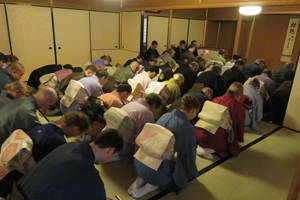 |
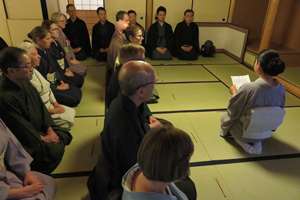 |
| The participants make a deep bow in thanks for the instruction. | Conveying words of thanks to the teachers. |
| Iemoto Zabosai presented a special 80 min. lecture to the participants the morning of the third day, June 28, in the lecture room of the Urasenke Gakuen. The International Affairs Department had equipment readied for this, to provide simultaneous English translation. The lecture moved across a number of thought-provoking themes, the main underlying theme being that we must always think of the basics and approach them diligently and studiously. This lecture ended the study program at Konnichian. |
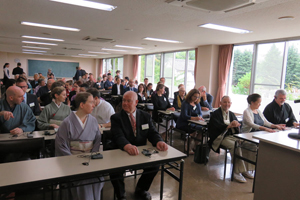 |
| Jovial classroom atmosphere the morning of the third day, after the previous two days of tea room seiza sitting. |
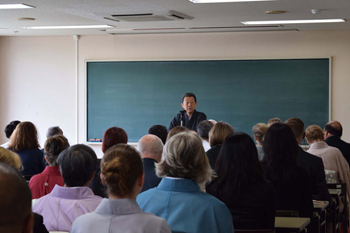 |
| Iemoto Zabosai presents an absorbing lecture. |
| In the afternoon of the third day, after going for lunch at the Zen vegetarian cuisine restaurant Izusen, near Daitokuji temple, the participants returned to the morning's classroom for a UMAA planning meeting, in which the current Midorikai students also took part. The meeting was chaired by UMAA Vice President Karl FOOKS and UMAA Treasurer Christy BARTLETT. The UMAA had invited Iemoto’s daughter, SAKATA Makiko, to attend this and present an opening speech, which she graciously did. During the meeting, Vice President Fooks presented thank you presents to those who had played particularly key roles in making this time’s special study seminar a reality. |
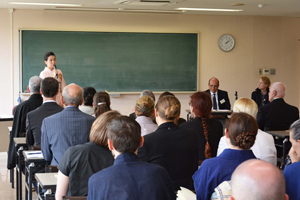 |
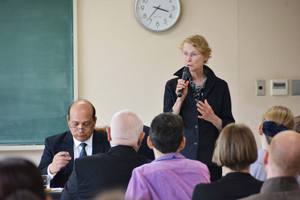 |
| Sakata Makiko presents opening words at the meeting. | Treasurer Christy Bartlett speaks at the meeting. |
| The schedule for the next two days comprised optional study opportunities which the organizers of this entire program in Kyoto had arranged. On Friday, June 29, a group of seventeen went to the Katsuragama pottery studio and tried making Raku-style tea bowls. A group of eighteen visited Ippodo, a producer of matcha, to learn about koicha production and the packing of the chatsubo tea jar. They also took part in a tea tasting to determine three varieties of koicha. A group of nineteen went to Suetomi, a producer of chanoyu sweets, to learn how to make an (sweetened pureed beans) and to color and shape different types of sweets. Usucha was served in the shop's tea room with the sweets that the participants had made. On Saturday, June 30, RAKU Kichizaemon, the head of the Raku kiln, hosted forty-eight of the alumni in three seatings at a tea gathering which featured pieces made by the generations of his family. A group of fifteen went to Yamadamatsu, an incense-wood shop, for a Genjiko workshop, involving the monko (incense appreciation) activity of heating several varieties of incense wood one at a time, testing their fragrance, and attempting to recognize them. With this, the special study program in Kyoto which the UMAA had organized came to an end. |
| HOME |